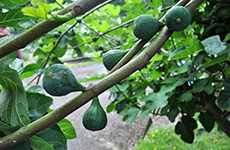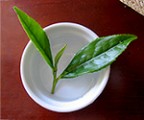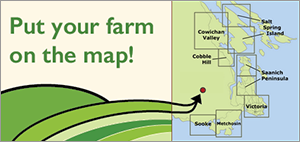Growing a Local Mediterranean Diet
Citrus Fruits, Olives and Pomegranates on Vancouver Island

Bob Duncan of Fruit Trees and More has pioneered ways to cultivate kiwis, oranges and other subtropical fruit on Vancouver Island.
Scientific studies have long hailed a Mediterranean diet of oranges, olives and subtropical fruits, along with vegetables, nuts, legumes and grains, as one of the healthiest in the world. Until now, however, British Columbia food distributors have had to import most of these subtropical foods from California and Mexico. While growers in BC are able to produce some Mediterranean vegetables, such as tomatoes and peppers, citrus fruits have been seen as unsuited to the growing conditions in this region.
Thanks to the pioneering work of Bob and Verna Duncan of Fruit Trees and More, a demonstration orchard and nursery in North Saanich, BC, citrus fruits, olives, figs and pomegranates are now within reach of backyard gardeners and farmers.
Over the last two decades the Duncans, who cultivate over 300 varieties of fruit trees, have systematically searched the world for temperate and subtropical fruits that will grow successfully in the Pacific maritime climate on Vancouver Island.



Oranges, olives and apricots at Fruit Trees and More on Vancouver Island.
A Climate for Mediterranean Fruits
“Here on the south end of Vancouver Island, there is the potential to be self-reliant in the production of all the temperate fruits and most of the fruits we think of as Mediterranean,” says Bob Duncan. These include everything from common cultivars like apples, pears, and plums to subtropical oranges, lemons, limes, olives, figs, pomegranates, and loquats.
At Fruit Trees and More, Duncan seeks out dwarf trees that have good tasting fruit, are highly productive, manageable without ladders, and can grow on Vancouver Island without the need for a heated greenhouse. By selecting well-suited varieties, siting them carefully, and providing minimal frost protection, he has pioneered the cultivation of many subtropical fruits that normally could not grow in the region.
Moderate Winters and Low Summer Heat

A lemon tree, grown against a south-facing wall to trap the warmth, thrives outdoors in the BC south coast maritime climate.
“The climate here is often described as a modified Mediterranean climate,” says Duncan. “Temperatures below -10º Celsius are relatively rare, which means that basically all the Mediterranean tree fruits will survive the winter here.” Over the past 20 years of observational growing, Duncan has noticed a trend toward milder winters, which favours the growth of these warm weather trees.
“The problem is more a lack of summer heat,” he says, “so we often need to devise means of generating a few extra heat units in the summer.” That can mean creating microclimates to augment the heat—for example, growing lemons against a sunny south-facing wall, and using Reemay covers and Christmas lights to protect them during frosts.
It can also mean selecting tree varieties that yield the most in this climate. In figs, which have an early and a main crop, Duncan explains: “because our summers are much cooler than in true Mediterranean climates, we typically only ripen the first crop, or the breva crop, as it is known.”
By focusing on fig varieties, such as Desert King, which have a large first crop, Duncan has found a way to grow high-quality figs that outproduce commonly sold fig trees in the region.
Video >
 Growing Mediterranean Fruit on Vancouver Island:
Growing Mediterranean Fruit on Vancouver Island:
A Tour of Fruit Trees and More
Cultivating a Local Mediterranean Diet
By pushing climate limits, Duncan has made the possibility of growing and eating a local Mediterranean diet a reality. Scientific studies have cited the Mediterranean diet, with its reliance on citrus and subtropical fruits along with vegetables, olive oil, nuts, legumes and grains, as promoting longevity and affording protection against heart disease, cancer, and other diseases.
So for Vancouver Island and south coast British Columbia the possibilities of cultivating Mediterranean fruits are great. “Most of these fruits can actually be grown here,” says Duncan. “I’m always looking for new and interesting types of fruit…. The reality is, as we’ve been able to demonstrate over the last two decades, it is possible to grow a tremendous diversity of fruit.”
If it is true that the greatest service individuals can do for their community is to introduce new foods, by developing methods for growing citrus fruits and other Mediterranean trees on Vancouver Island the Duncans have served their community very well.



Cherries, kumquats and figs at Fruit Trees and More on Vancouver Island.
More articles:
 A Low-Carbon Citrus Greenhouse in Canada
A Low-Carbon Citrus Greenhouse in Canada
 Teafarm Brews up a New Crop for Canada
Teafarm Brews up a New Crop for Canada
 In Search of the Local Bean
In Search of the Local Bean
 Grow a Climate Change Resilient Garden
Grow a Climate Change Resilient Garden
 10 Tips for Year-Round Vegetable Gardens
10 Tips for Year-Round Vegetable Gardens













Hi, we live in Cumberland in the comox valley. I would love to grow oranges, lemons and olives. I have two questions, will they grow and fruit this far north on the island? Can you grow mini varieties in pots, our garden space is kind of limited? Thanks :)
Wondering how pomegranate would grow here in Summerland (Zone 6b?)
Hi you need at least a zone 7b
We sell fig trees at our nursery. Hope this link on looking after your fig trees is helpful.
How to prune figs in a cool climate for first (breba) crop fig production: https://www.youtube.com/watch?v=RB0D_tuKgtQ
My wife has a very large DESERT KING fig tree in our back yard. It yields about 80 lbs of figs each season. But she has tried for many years to “start” another tree but no luck. What is the best method & time to try?
Thanks.